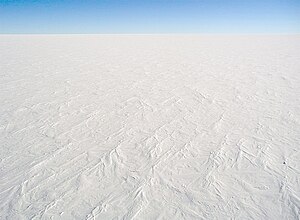 |
| Etelämantereen jäätikköä kuva wikimedia |
An ice age, or more precisely, a glacial age, is a period of long-term reduction in the temperature of the Earth's surface and atmosphere, resulting in the presence or expansion of continental and polar ice sheets and alpine glaciers. Within a long-term ice age, individual pulses of cold climate are termed "glacial periods" (or alternatively "glacials" or "glaciations" or colloquially as "ice age"), and intermittent warm periods are called "interglacials". Glaciologically, ice age implies the presence of extensive ice sheets in the northern and southern hemispheres. By this definition, we are still in the ice age that began 2.6 million years ago at the start of the Pleistocene epoch, because the Greenland, Arctic, and Antarctic ice sheets still exist.
| kaavio wikimedia |
There have been at least five major ice ages in the Earth's past
- Huronian
- Cryogenian
- Andean-Saharan
- Karoo Ice Age
- Pliocene-Quaternary
Outside these ages, the Earth seems to have been ice-free even in high latitudes
Huronian
Rocks from the earliest well established ice age, called the Huronian, formed around 2.4 to 2.1 Ga (billion years) ago during the early Proterozoic Eon. Several hundreds of km of the Huronian Supergroup are exposed 10–100 km north of the north shore of Lake Huron extending from near Sault Ste. Marie to Sudbury, northeast of Lake Huron, with giant layers of now-lithified till beds, dropstones, varves, outwash, and scoured basement rocks. Correlative Huronian deposits have been found near Marquette, Michigan, and correlation has been made with Paleoproterozic glacial deposits from Western Australia.
Cryogenian (Snowball Earth)
 |
| Arrival of Cryogenian image NASA |
"The presence of ice on the continents and pack ice on the oceans would inhibit both silicate weathering and photosynthesis, which are the two major sinks for CO2 at present." It has been suggested that the end of this ice age was responsible for the subsequent Ediacaran and Cambrian Explosion, though this model is recent and controversial.
Andean-Saharan
The Andean-Saharan occurred from 460 to 420 million years ago, during the Late Ordovician and the Silurian period.
Karoo Ice Age
The evolution of land plants at the onset of the Devonian period caused a long term increase in planetary oxygen levels and reduction of CO2 levels, which resulted in the Karoo Ice Age. It is named after the glacial tills found in the Karoo region of South Africa, where evidence for this ice age was first clearly identified. There were extensive polar ice caps at intervals from 360 to 260 million years ago in South Africa during the Carboniferous and early Permian Periods. Correlatives are known from Argentina, also in the center of the ancient supercontinent Gondwanaland.
Pliocene-Quaternary
 |
| Scandinavia under ice kuva wikimedia |
Lue koko artikkeli wikipedia
| Sarja | Vaihe | Alivaihe | Kronozooni | Aika vuotta sitten |
|---|---|---|---|---|
| Holoseeni | Preboreaali | 10 640–11 560 | ||
| Pleistoseeni | Veiksel-jääkausi | Jääkauden loppuvaihe | Nuorempi Dryas | 11 560–12 700 |
| Allerød | 12 700–13 350 | |||
| Vanhempi Dryas | 13 350–13 480 | |||
| Bølling | 13 480–13 730 | |||
| Vanhin Dryas | 13 780–13 860 | |||
| Meiendorf | 13 860–14 500 | |||
| Keski-Veiksel-kausi | ||||
| LGM | 18 000–28 000 | |||
| Denekamp | 28 000–32 000 | |||
| Hengelo | 36 900–38 700 | |||
| Moershoofd | ||||
| Glinde | 48 000–51 000 | |||
| Ebersdorf | ||||
| Oerel | 55 400–57 700 | |||
| Schalkholz | ||||
| Varhaisjääkausi | Odderade | ±74 000 | ||
| Rederstall | ||||
| Brørup | ||||
| Herning | -116 000 | |||
| Eem | 116 000–128 000 | |||
| Sinertävä, kylmää, punertava, lämmintä | ||||
kaavio suomalainen wikipedia

Ei kommentteja:
Lähetä kommentti